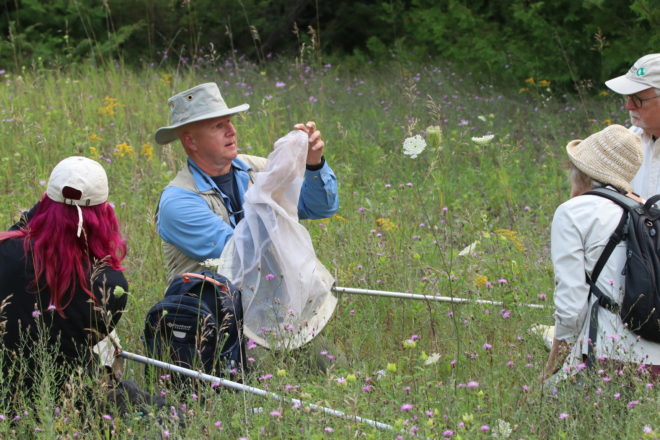Door County’s Green-eyed Success Story
- Share
- Tweet
- Pin
- Share

Endangered Species Act turns 50 this year
The population of a rare dragonfly has rebounded along with habitat-preservation successes in Door County as the 50th anniversary of the Endangered Species Act approaches this year on Dec. 28, 2023. Landmark nationwide victories – including the comebacks of bald eagles, alligators and peregrine falcons – occurred fewer than 30 years after the federal law took effect in 1973.
In Wisconsin, the wins in protecting less iconic species – such as the Baraboo area’s whooping crane flocks and Door County’s large population of Hine’s emerald dragonflies – came and went in more recent years with much less publicity.
“It was thought to be extinct until the 1980s or even 1990s,” said Dan Soluk, a foremost researcher of Hine’s emerald dragonflies. The North Dakota State professor said the dragonfly had been considered extinct since the 1950s, when one was recorded in Ohio, but then one was found in a suburban Chicago wetlands near the Des Plaines River. Another was described soon afterward near the Mink River Estuary east of Ellison Bay.
“Door County is the best place in the world for this species,” said Soluk, who previously worked for the Illinois Natural History Survey and today accompanies teams for trips to the northern Door peninsula for studies and egg collection for a rearing program that bolsters the county’s dragonfly numbers.
Soluk said the Door County population is thriving because of land-purchase efforts and habitat protection in a swath spanning from Shivering Sands State Natural Area in the Town of Sevastopol to lowlands south of Newport State Park. He said roadway surveys indicate that up to 2,000 Hine’s emerald dragonflies are killed each summer by cars on Highway Q in Door County – proof that the insect is thriving at The Ridges Sanctuary and Mud Lake State Natural Area.
The dragonflies also flourish at Nature Conservancy preserves north of Kangaroo Lake, remote wetlands in its North Bay nature area and upper reaches of the Mink River, Soluk said.
“At Toft Point, you could see more of these flying around in one big swarm than we think are in the entire state of Illinois,” he said.
Although Door County in 2013 had an estimated population of 20,000 Hine’s emerald dragonflies – or two-thirds of the worldwide population – Soluk said the county’s population possesses much less genetic diversity than that of the habitat-impaired Chicago suburban region.
He has doubts about how well Door County’s green-eyed dragonflies can adapt to climate-change impacts between now and 2050. Soluk pointed to climate models predicting that Door County could see temperature increases and a climate similar to Chicago’s by then, which also would mean that the wetlands where these dragonflies breed, live and emerge as adults could dry up earlier each summer.
For that reason, and because of the tininess of populations near Chicago and in the south-central Missouri Ozarks, Soluk does not believe the Hine’s emerald dragonfly can come off the endangered-species list like the brown pelican and American alligator.
“The Illinois population in the Des Plaines River valley is only producing somewhere around 300 animals, maybe less, in a year. For a dragonfly, that’s a really small population,” Soluk said. “Even though right now the Door County population is in really good shape, as far as we know, that doesn’t mean it’s going to remain that way.”
Dragonfly Susceptible to Wetland Pollutants

This particular species of dragonfly has a five-year life cycle that makes it amazingly susceptible to any pollutants in the spring-fed and groundwater-fed wetlands it calls home. Unlike Chicago, the northern Door County groundwater-recharge areas surrounding those wetlands have little contamination so far, Soluk noted.
“They live in tiny areas of streams and flowing wetlands that are connected to groundwater. It’s vulnerable because it has a long life cycle. Most of that is spent as a larva,” Soluk said of the short, squat insect form that’s slightly “furry” compared to other dragonfly larvae. “In Door County, it might spend four or five years as a larva, and then as an adult, maybe six to eight weeks. It can survive for a week or so out of the water when wetlands dry up.
“One of the most unique things about this species is when that happens, they move into crayfish burrows. And crayfish will also kill them and eat them. But it’s a great place to go otherwise,” Soluk said of the burrows and some of the larvae’s dark, dangerous hiding spots.
Any short-term contamination of water or those hiding places can kill multiple generations of this peculiar species of dragonfly. In Door County, they live in protected locations surrounded by lands that are not yet very developed. In Illinois, an oil spill, new industrial or commercial development, water extraction for mining or other factors can kill several years’ hatchlings.
In Door County, The Nature Conservancy, The Ridges Sanctuary, the Door County Land Trust and the Department of Natural Resources have all contributed to this dragonfly’s comeback story, said The Nature Conservancy’s Emily Mills.
“It’s a whole landscape that’s protected by multiple agencies and multiple entities, all with the goal of protection of these resources and the Hine’s emerald dragonfly,” said The Nature Conservancy’s Door peninsula land steward, Kari Hagenow, of the many contiguous Door County natural areas.
Hagenow does her part in reminding area landowners to stay vigilant in protecting lands that feed groundwater into the dragonfly habitats. She also leads The Nature Conservancy’s efforts to protect nature-preserve quality by eliminating threats to wetland habitat such as invasive, nonnative plants such as reed canary grass and phragmites.
Endangered Species Act Boosts Public Awareness

Various lands in northeastern Door County have been designated a RAMSAR Wetland of International Importance in recognition of the habitats of the Hine’s emerald dragonfly, several endangered and rare orchids around The Ridges, boreal forest and the various types of wetlands. The designation also recognizes Door County’s importance to water quality along Lake Michigan’s shoreline and ideal habitats for various plants and animals in the county.
That designation, as well as the endangered-species listings of the Hine’s emerald dragonfly, various orchids and the rusty-patched bumblebee, give a big boost to funding for scientists’ work, habitat-protection jobs and studies.
The Endangered Species Act’s link to Door County has also helped naturalists and organizations to educate the public about the importance of critical habitats, and it has helped organizations to win grants to pay for land acquisition, land management and expanded protection of habitat, said Mike Grimm, a Door County-based conservation ecologist for The Nature Conservancy.
“Some of the biggest successes of the Endangered Species Act are just bringing awareness to the public,” he said. “We share the planet with a whole suite of beautiful creatures that are being imperiled by our actions.”




